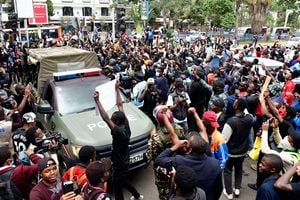
A man kicks a tear gas canister in Nairobi on June 18, 2024 during a protest against the Finance Bill, 2024
University students and young professionals were heavily involved in the planning and execution of the protests against the Finance Bill,2024, interviews with the Sunday Nation reveal.
Beneath the open defiance by the youthful protesters lay meticulous planning that caught security agencies flat-footed even as more marches are planned in the coming days.
The protests drew out thousands of young people, many commonly referred to as Generation Z, in a revolt against the bill that seeks to raise and introduce punitive taxes. Police appeared to have largely controlled exuberant youth in Nairobi on Tuesday.
It was a different matter altogether two days later when the energy of thousands of young people poured into streets in Nairobi, Kisumu, Mombasa, Eldoret, Nakuru, Kericho, Lodwar, Kilifi, Nyeri, Isiolo, Meru, Embu, Nanyuki, Kisii, Kakamega, Machakos, Kiambu among other towns.
They arrived waving colourful and witty placards. The arrival was not in large groups and neither were they dropped off in buses or trucks.
“We’re all over but we’ve not yet started the protests. You can’t know. We’ll occupy the City Centre in 30 minutes. Police won’t know how to deal with us but our voices must be heard. I’m in-charge of a group of 500,” one of the organisers told the Sunday Nation in Nairobi.
The Third-Year University of Nairobi student chose to remain anonymous for safety reasons.
“Our movement is in different parts of Nairobi and the rest of the country,” she said.
Minutes after the interview, streets in the City Centre were full of thousands of young Kenyans chanting, blowing whistles and singing.
In a characteristic fashion, police officers responded in the way they know best – tear gas, clubs and firing in the air.
Unlike past political agitation, young women have been heavily involved in the planning and actual picketing.
“These are the people who were born at the tail-end of the Kanu rule or were weaned on the freedom that came with the Mwai Kibaki administration. They are well-educated and benefited from reforms, including the Children’s Act, which outlawed corporal punishment,” Dr Isaac Micheni, a healthcare practitioner, told the Sunday Nation.
“They know their rights. You can’t oppress them because they’ll resist.”
Social groups
The young men and women in Nairobi and other parts of the country are organised in social groups where they retreat virtually to plan and debrief after the protests.
The main agenda of the discussions has been rallying under #RejectFinanceBill2024 and castigating the proponents of the bill.
There are main groups, which are open to all. Coordination is done in closed micro-groups.
“The micro-groups are for the main organisers. We must know you personally. Your character and integrity will determine your inclusion,” the UoN student said.
“We know intelligence agencies and their informers infiltrate such groups.”
Group members are reminded of the importance of picketing with decorum and remaining non-violent. They are also reminded of the importance of technology.
Apart from organising the demonstrations, the protesters have used digital technology to expose police officers who brutalise them.
The youth are organised in groups and assigned streets for maximum impact and to outnumber police.
The protesters make use of a “Walkie Talkie” phone app.
Dress in black
The application turns a phone into a communication system they use to warn one another of the whereabouts of police officers and the routes to use.
The organisers asked protesters to dress in black on Tuesday, the first day of the marches.
It was easy to identify them but when the planners retreated to take stock of the day’s events in the evening, that was considered a give-away.
To prepare for Thursday’s protest, a communication was circulated that the participants be “colourful and elegant”, a strategy that seemed to make it difficult for the police to identify them.
The young Kenyans are making great use of social media platforms, including WhatsApp, TikTok and X.
Graduates are educating the rest and sharing their expertise on the matter at hand.
On Saturday, June 22, a discussion on X Spaces attracted more than 60,000 listeners for hours. The number was almost steady as participants tuned in and out.
The Space ran under the title “Good Morning Kenya: Where is Crazy Nairobian?” It was formed to agitate for the release of a blogger who calls himself Billy the Goat (@_CrazyNairobian) on X. He is said to have been arrested and taken to an undisclosed location on Friday.
Speakers called on young people to register as voters.
Austin Omondi, who describes himself as a jobless doctor, said on the X Space that for next protests, there would be medical camps at Jamia Mosque and All Saints Cathedral.
“We had nine ambulances and are requesting for more. I was beaten by a police officer but when one of them was injured, he came for treatment” he said.









